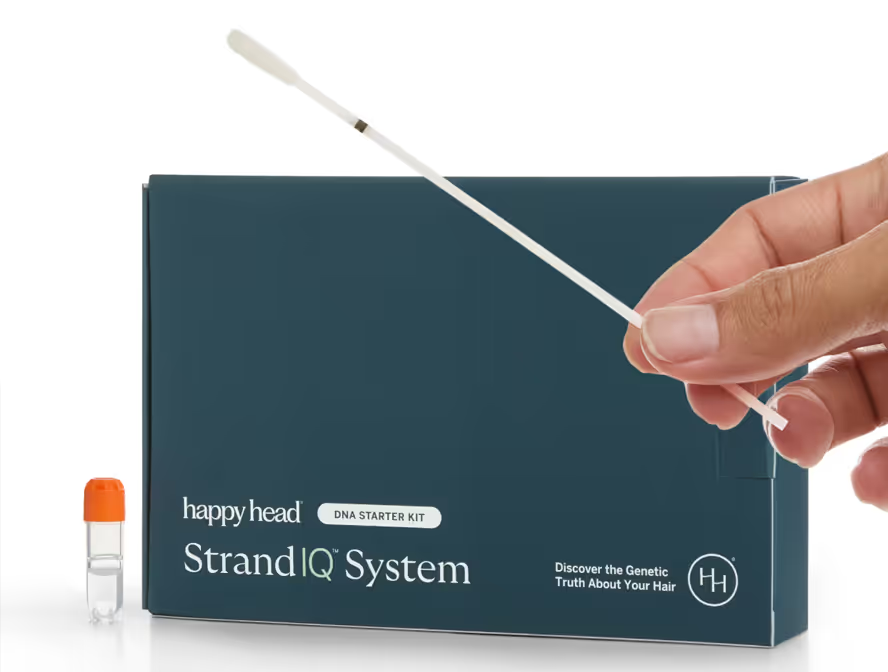Vitamin B3, also known as niacin, plays a much larger role in your scalp and hair vitality than most people realize. From improving blood circulation to reducing oxidative stress and strengthening the skin barrier, niacin is critical for healthy hair growth and scalp resilience.
But if your genes limit your ability to process or retain niacin, your scalp may become more prone to inflammation, irritation, and slower healing. Left unaddressed, this can lead to reduced hair density, especially after shedding episodes—or when dietary gaps or alcohol use are added to the mix.
Continue reading for more information on how to recognize the signs of low vitamin B3 activity and what you can do about it based on your genetic risk level.
The Science Behind Niacin and Scalp Health
Vitamin B3 is a water-soluble nutrient that supports:
- Capillary circulation to the scalp, enhancing nutrient and oxygen delivery
- Skin barrier function, which protects against environmental damage
- Antioxidant defenses, helping to neutralize free radicals
- Repair and recovery from inflammation or physical damage (e.g., tight hairstyles, chemical treatments, etc.)
People with certain genetic variants—including those affecting NADSYN1 or NAPRT—may metabolize or retain niacin less efficiently. This creates a higher risk for niacin insufficiency, which can manifest in the skin, hair, and neurological system.
Common Signs of Niacin Deficiency
Even if you’re eating niacin-rich foods, weak processing can still lead to:
- Irritated, inflamed, or itchy scalp
- Delayed healing from scalp injury or styling stress
- Increased hair thinning or poor regrowth
- General wellness changes such as feeling low energy or mood fluctuations, which should always be evaluated by a medical professional if persistent
If any of these sound familiar you might be at a greater risk than you think.
Recommendations Based on Your Niacin Processing Risk
Your scalp health and hair growth rely on maintaining consistent, bioavailable levels of vitamin B3 (niacin). Here’s how to optimize your intake and minimize loss, based on your Happy Head StrandIQ genetic profile.
Low Genetic Risk: Maintain Niacin-Rich Habits
If your StrandIQ analysis has identified you as having an efficient vitamin B3 metabolism, you may only need to focus on dietary consistency and minimize depletion from common lifestyle factors.
- Include niacin-rich foods
Add servings of salmon, anchovies, liver, potatoes, mushrooms, or peanuts to your weekly routine. These are among the highest natural sources. - Enjoy fortified foods
Many breakfast cereals, flours, and grain products are fortified with niacin—especially important if you follow a plant-based or lower-meat diet. - Hydrate and balance meals
Niacin is water-soluble, so staying well-hydrated helps your body absorb and transport it effectively. - Monitor alcohol intake
Chronic or even moderate alcohol consumption can interfere with niacin metabolism. Stick to moderation, or pair alcohol with niacin-rich meals to offset potential losses.
Medium Genetic Risk: Be Intentional With Diet, Lifestyle, and Awareness
If your genetic analysis suggests less efficient niacin retention or conversion, take a proactive approach to ensure your body meets its daily needs.
- Diversify your niacin sources
Rotate between animal-based (liver, salmon, anchovies) and plant-based (beets, peanuts, mushrooms) options for better coverage. - Lean into nutrient pairings
Combine niacin-rich meals with foods containing vitamin B6 or tryptophan (e.g., turkey, bananas, eggs), which can help support your body’s natural niacin synthesis. - Minimize niacin-draining habits
Reduce alcohol consumption, especially during periods of stress, illness, or poor sleep—all of which can increase nutritional demands. - Check for subtle signs
Symptoms like fatigue, mood swings, poor focus, or thinning hair may point to low niacin availability. If they persist, ask your provider for a nutrient panel. - Evaluate supplements cautiously Some hair, skin, and nail supplements contain niacinamide—a form of vitamin B3. Talk to your Happy Head dermatologist before adding anything new, especially if you’re on medication.
High Genetic Risk: Focus on Medical Guidance, and Prevention
If your Happy Head StrandIQ analysis has determined you are at a high-risk for processing or retaining niacin inefficiently—increasing your vulnerability to inflammation, poor healing, and hair thinning over time—here are a few quick steps to follow:
- Emphasize bioavailable sources
Prioritize foods like grass-fed liver, wild-caught salmon, sardines, mushrooms, and fortified cereals at least four to five times per week. - Limit alcohol strictly
Even occasional alcohol intake can rapidly deplete niacin stores in high-risk individuals. If abstaining isn’t an option, always pair drinks with nutrient-dense meals. - Incorporate scalp-friendly nutrients
Niacin works synergistically with zinc, biotin, and antioxidants. Look for hair care products or oral supplements that combine these when recommended by a professional. - Consult before supplementing
High-dose niacin can cause flushing, dizziness, nausea, or liver stress. Work with a registered dietitian or physician to find the safest dose and form (such as niacinamide, which doesn’t cause flushing). - Know your drug interactions
If you take medications for blood pressure, cholesterol, or blood thinning, niacin supplements could interact. Always review your full medication list with your provider. - Track results
Consider keeping a scalp health journal noting irritation, flakiness, healing time, or hair growth changes—especially if you’re adjusting diet or supplementation.
Takeaway: Know Your Niacin Needs for Scalp and Hair Strength
Your ability to metabolize and retain vitamin B3 can make or break your scalp health and hair strength—especially when stress, styling, or lifestyle choices are involved.
Whether you’re genetically low-risk or high-risk, a personalized approach to diet, supplementation, and product use can help you maintain a balanced, well-nourished scalp and reduce risk of inflammation-related hair loss.
Resources
StrandIQ SNP Marker Count: 33
StrandIQ Genes for Trait:
AKR1B10, BLVRA, CLCN6, COA1, COL11A2, FASTKD3, FMO2, GPATCH4, GRHPR, GSTP1, HSD17B11, HSD17B14, JAZF1, KIF1B, LINC01337, MIR4276, MROH9, MTHFD1, MTRR, NAXE, NOS1, PLEKHA4, PPFIBP2, PTGR3, RXRB, STK17A, TMEM255A, TTC24, VN2R1P, Y_RNA, ZNF20, ZNF788P, ZRANB1
References:
Ames, B.N., et al. (2002). High-dose vitamin therapy stimulates variant enzymes with decreased coenzyme binding affinity (increased K(m)): relevance to genetic disease and polymorphisms. American Journal of Clinical Nutrition, 75(4), 616–658. PMID: 11916749.
Amini, F., et al. (2013). 3'-UTR variations and G6PD deficiency. Journal of Human Genetics, 58(4), 189–194. PMID: 23389243.
da Rocha, J., et al. (2021). G6PD variant distribution in sub-Saharan Africa and potential risks of using chloroquine/hydroxychloroquine based treatments for COVID-19. Pharmacogenomics Journal, 21(6), 649–656. PMID: 32577690.
Hu, L., et al. (2015). Secondary NAD+ deficiency in the inherited defect of glutamine synthetase. Journal of Inherited Metabolic Disease, 38(6), 1075–1083. PMID: 25896882.
Kleta, R., et al. (2004). Mutations in SLC6A19, encoding B0AT1, cause Hartnup disorder. Nature Genetics, 36(9), 999–1002. PMID: 15286787.
Seow, H.F., et al. (2004). Hartnup disorder is caused by mutations in the gene encoding the neutral amino acid transporter SLC6A19. Nature Genetics, 36(9), 1003–1007. PMID: 15286788.
Zapata-Pérez, R., et al. (2021). NAD+ homeostasis in human health and disease. EMBO Molecular Medicine, 13(7), e13943. PMID: 34041853.
This content, including StrandIQ™ DNA analysis reports and any Happy Head products and/or services referenced therein, is for informational and cosmetic purposes only. It is not intended to diagnose, treat, cure, or prevent any disease. This content does not constitute medical advice and should not be used to make healthcare decisions. References to prescription treatments are educational in nature. Always consult a licensed healthcare professional for any medical concerns or treatment decisions.








.avif)

